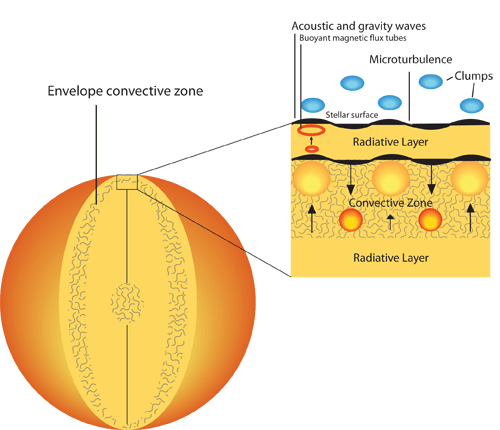Highlights - Volume 499-1 (May III 2009)
- Details
-
Published on 18 May 2009
PDF version
HIGHLIGHTS: this week in A&A
|
Volume 499-1 (May III 2009)
In section 7. Stellar structure and evolution
“Sub-surface convection zones in hot massive stars and their observable consequences”, by M. Cantiello et al., A&A 499, p. 279
Massive stars, in a general sense, have convective cores and radiative envelopes. Opacity peaks associated with iron and helium ionization, however, generate small convection zones in the envelope. Cantiello et al. explore the observational consequences of these convection zones, and find that the convection in the iron ionization zone naturally explain the observed microturbulent velocities of massive stars, with the correct dependencies on the stellar parameters. They also find that this convection can trigger non-radial pulsations, affect the wind clumping, and be responsible for magnetic fields. |

|
|
In section 6. Interstellar and circumstellar matter
“Increased complexity in interstellar chemistry: detection and chemical modeling of ethyl formate and n-propyl cyanide in Sagittarius B2(N)”, by A. Belloche et al., A&A 499, p. 215
The degree of complexity of the observed interstellar molecules obviously has some bearing on the development of complex species in the early solar system and the galactic center “hot core” Sgr B2(N) has been one of the most prolific sources of complex molecules. A step forward in our understanding has been a 3mm spectral survey carried out with the IRAM 30m telescope towards this source that has led to the detection inter alia of the species ethyl formate and n-propyl cyanide. The article by Belloche et al. highlighted in this issue reports these findings and presents chemical models suggesting that these species are mainly formed on grain surfaces.
|
|
In section 6. Interstellar and circumstellar matter
“Probing the role of protostellar feedback in clustered star formation. Mapping outflows in the collapsing protocluster NGC 2264-C”, by A.J. Maury et al., A&A 499, p. 175
Somewhat paradoxically, it has been found that one of the first signs of the presence of a protostar is the outflow of matter from its vicinity. It seems likely that outflows from young stellar objects influence the formation of the subsequent generation of protostars. This paper attempts to measure the extent of this influence and concludes that the outflows in NGC 2264-C are presently incapable of supporting the protocluster against global collapse though it seems possible that, in the future, they may be able to do so.
|
|
In section 9. The Sun
“Explanation of the activity sensitivity of Mn I 5394.7 Å”, by N. Vitas et al., A&A 499, p. 301
This paper clearly demonstrates that the variability of the MgI line, which has been used as a solar activity proxy, is caused by its sensitivity to deep photospheric magnetic flux concentrations. This clarifies a long discussion
if the sensitivity of this line could be related to chromospheric lines.
|
You can now receive the A&A weekly Highlights by email. To subscribe to the A&A Highlights emailing list, please send an email to This email address is being protected from spambots. You need JavaScript enabled to view it.
© Astronomy & Astrophysics 2009


